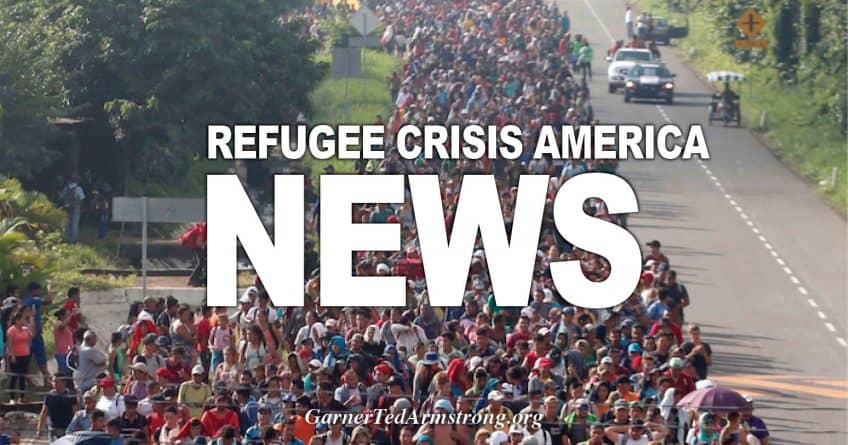The Mexican authorities used pepper spray on a caravan of 4,000 Central American migrants who tried to enter the country illegally and dangled the possibility of jobs for those who registered.
MEXICO CITY — For generations, Mexico served as a relatively open thruway for undocumented migrants traveling to the United States. Tens of thousands crossed the country every year, mostly unimpeded by the Mexican authorities.
But the Mexican government’s new hard-line posture on migration entered a new phase this week with its iron-fisted response to a large migrant caravan of Central Americans who sought to enter Mexico.
The Mexican government effectively dismantled the caravan at the nation’s southern border in recent days, using a combination of carrots and sticks — the lure of possible employment for those who chose to enter legally, and pepper spray, detention, and deportation for those who did not.
By Friday, a caravan that had numbered as many as 4,000 a week ago had dwindled to several dozen, most of them languishing in Ciudad Tecún Umán in Guatemala, where they were considering their dashed hopes and next moves. More than 1,000 were sent back to Honduras and another 800 or so remained in detention in Mexico, government authorities said.
“I didn’t cross because I saw the difficulties,” said Rony Benitez, 49, a bus driver from Honduras, who was sitting on a sidewalk in Tecún Umán on Friday morning. “I’m done with the caravan.”

Credit…Johan Ordonez/Agence France-Presse — Getty Images
The caravan was perhaps the biggest and most dramatic test to date of Mexico’s new resolve to get tough on illegal migration. The policy shift began last year under pressure from President Trump, who threatened to close the border and impose tariffs, demanding that the Mexican government do more to curb the flow of migrants passing through its territory on their way to the United States.
The crackdown led to intense scenes this week of Mexican security forces dressed in riot gear repelling or rounding up Central American migrants who tried to cross Mexico’s southern border en masse.
The tactics drew the criticism of immigrants’ advocates and even some Mexican officials who accused the authorities of committing human rights violations by using excessive force. But the Trump administration applauded the efforts, congratulating the Mexican government for its tougher line on migration.
Kenneth T. Cuccinelli II, the acting deputy Homeland Security secretary, told reporters on Friday that the Trump administration had seen more cooperation from Mexico, as well as from El Salvador, Honduras, and Guatemala, “than anyone thought was possible.”
He said the enforcement was partly the result of the diversion of dozens of Homeland Security agents to the region to train local authorities to stop migration to the United States. He added that next week the administration would begin carrying out a deal with Honduras to deport asylum-seekers back to Honduras.
For his part, President of Mexico defended his government’s response to the caravan and said its security forces had respected human rights and acted with professionalism.
“The problem has been resolved well,” he said during a news conference on Friday. “Fortunately, human rights have been respected.”
The Mexican administration’s response to the caravan was a sharp departure from its approach to similar mass migrations just a year ago.
Mr. López Obrador took office in December 2018 amid a surge in migration from Central America, as thousands fled poverty, violence and government dysfunction and sought to reach the southwest border of the United States.
But instead of impeding that flow, Mr. López Obrador, a lifelong populist, and champion of the poor, opened the door even wider, promising work opportunities in Mexico and distributing yearlong humanitarian visas to just about anyone who applied.
As he rejected what he called the enforcement-first approach of his predecessors, deportations from Mexico plummeted.
But the permissiveness seemed to encourage even more migration, angering Mr. Trump, who threatened Mexico with crippling tariffs and the closure of the United States-Mexico border. In response, Mexico began cracking down on illegal migration, sharply increasing the detentions of undocumented migrants.
At the same time, Mr. Trump also compelled his counterparts in Central America to step up their enforcement efforts and pressured the Northern Triangle countries — Guatemala, Honduras, and El Salvador — to sign agreements requiring migrants who passed through one of those countries to first seek asylum there before applying in the United States.

Credit…Alfredo Estrella/Agence France-Presse — Getty Images
As a result of these measures, northbound migration through Mexico to the United States border has ebbed considerably in recent months.
But this wave of increasingly restrictive policies throughout the region did not discourage the latest migrant caravan from forming.
Its members, traveling on foot and hitchhiking, set off early last week from the city of San Pedro Sula in northern Honduras. The group grew in size as it headed north through Guatemala.
As the caravan approached the Mexican border, the Mexican authorities issued warnings that illegal crossings would not be tolerated and urged the migrants to register at official border crossings. Mr. López Obrador also dangled the possibility of employment for those who seek to enter legally, saying that there were 4,000 jobs in Mexico’s southern region that needed to be filled.
While some of the caravan’s participants presented themselves at legal border crossings, thousands more grew frustrated with the bottlenecks and sought to cross by other means, setting up a series of confrontations with the Mexican authorities.
On Jan. 18, hundreds of migrants in the vanguard of the caravan surged across a bridge linking the Guatemalan city of Tecún Umán with the Mexican city of Ciudad Hidalgo and came face to face with troops from Mexico’s National Guard, who blocked their path.
A full-blown melee erupted as the migrants tried to break through the Mexican defenses and the National Guard forces pushed back with riot shields and pepper spray.

Credit…Marco Ugarte/Associated Press
As tensions settled, 20 migrants at a time were permitted to enter and register with the Mexican migration authorities. But some became angry, and others despaired when they found out that the Mexican government intended to send most of those who registered back to their countries of origin.
Two days later, more than 1,000 migrants tried to force their way from Guatemala into Mexico by fording a river that separates the two countries and storming up a steep riverbank before being repelled by Mexican security forces wielding riot shields and truncheons.
Though some of the migrants sneaked through the security phalanx, most scrambled back into Guatemala.
A third showdown — and perhaps the final blow for the migrant caravan — came on Thursday, when about 1,000 migrants crossed the border illegally and started walking toward the city of Tapachula. Hours later, they were cut off and surrounded by roughly 200 members of Mexico’s security forces, who used pepper spray to subdue those who resisted or tried to flee.

Credit…Alfredo Estrella/Agence France-Presse — Getty Images
The migrants were eventually forced onto buses and taken to detention centers.
The Mexican authorities said that the more than 1,000 migrants who have been returned to Honduras had gone voluntarily. It was unclear whether the roughly 800 who were in detention were facing deportation, or whether they would be allowed to stay while they petitioned for asylum or another kind of immigration relief.
At least 1,800 members of the caravan had registered at official border crossings, government officials said, while hundreds of others were thought to have made it into Mexico’s interior. Some who were part of the caravan never left Guatemala and instead turned around and went home, officials said.
Mr. López Obrador said Friday that many in the caravan had been “tricked” into believing that passage into Mexico was going to be easier.
“They were told that they were going to pass through the national territory without a problem,” he said.
Kirk Semple reported from Mexico City, and Brent McDonald from Ciudad Hidalgo, Mexico, and Ciudad Tecún Umán, Guatemala. Sofía Menchú contributed reporting from Ciudad Tecún Umán, Guatemala, and Zolan Kanno-Youngs from Washington.
Source: https://www.nytimes.com/2020/01/24/world/americas/migrant-caravan-mexico.html
[Disclaimer]








